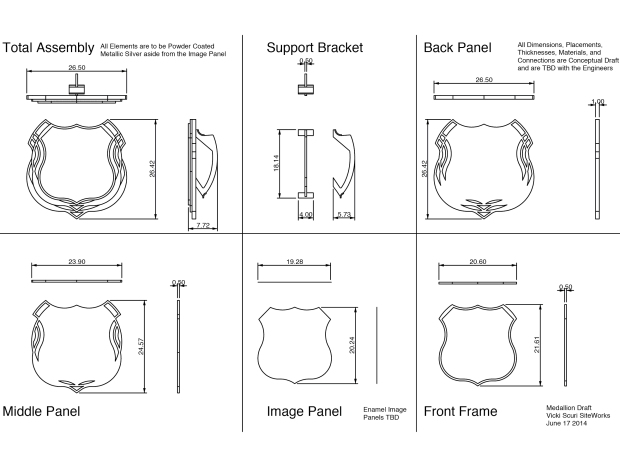Tulsa Medallions: Heritage through Art
 The balcony at the end of the I-244 overlook, seen above, provides a viewing platform over the Arkansas River and to the historic Route 66 11th Street Bridge below. The open side curves outward and provides a location for a series of artistic medallions placed on the handrail. The frames of these medallions relate to Tulsa’s Art Deco heritage, its Route 66 history and the Arkansas River. The faces of the medallions carry collages with images from local and historic sources.
The balcony at the end of the I-244 overlook, seen above, provides a viewing platform over the Arkansas River and to the historic Route 66 11th Street Bridge below. The open side curves outward and provides a location for a series of artistic medallions placed on the handrail. The frames of these medallions relate to Tulsa’s Art Deco heritage, its Route 66 history and the Arkansas River. The faces of the medallions carry collages with images from local and historic sources. A decorative frame surrounds the medallion’s form, derived from the Route 66 highway sign shield shape. The frame interprets the swirls and flow of the river below with an Art Deco perspective. This contemporary design with historical connection heightens the sense of place. Above are four iterations of the design shown as they would be at the site, in a series of five.
A decorative frame surrounds the medallion’s form, derived from the Route 66 highway sign shield shape. The frame interprets the swirls and flow of the river below with an Art Deco perspective. This contemporary design with historical connection heightens the sense of place. Above are four iterations of the design shown as they would be at the site, in a series of five.
Our design process is iterative, we study many variations of a design, learning from this process and improving the design to find the best solution. For the medallion frames we started with a circle surrounding the frame. This was then broken and influenced by the shield shape with a stack of curving layers, above top left. This complex solution was a good start but needed to be simplified to be realizable. The second scheme, above top right, tried to do this with limited success. The third scheme, above lower left, added complexity and grace back into the frame by introducing windows. The fourth scheme, above lower right, reintroduced the curving lines from the first scheme into the windows of the third. However, the line-work is too uniform and felt “spaghetti-like.” Our final design, above, builds on the information we gained by doing our iterations. It incorporates curving windows created by the complexities of the combinations of the shield and circle shapes. It also has thicker and thiner lines, establishing a hierarchy and strengthening the form. We also simplified its construction into three layers that work as a frame and work with the support that complements the handrail bracket.
Our final design, above, builds on the information we gained by doing our iterations. It incorporates curving windows created by the complexities of the combinations of the shield and circle shapes. It also has thicker and thiner lines, establishing a hierarchy and strengthening the form. We also simplified its construction into three layers that work as a frame and work with the support that complements the handrail bracket. Putting an image into a mock up, above, allows us to test the viability of the design. The shield shape makes a dynamic silhouette and the new frame adds interest to the shape while tying it into its surroundings.
Putting an image into a mock up, above, allows us to test the viability of the design. The shield shape makes a dynamic silhouette and the new frame adds interest to the shape while tying it into its surroundings. Our process, working in Rhino, allows us to quickly transform our 3D designs into drawings, above, that we can give to engineers for advice and approval. This allows both us and the engineers to see the final design intent and the possible component parts that make up the piece. This way every part and step of the process reinforces the design concept.
Our process, working in Rhino, allows us to quickly transform our 3D designs into drawings, above, that we can give to engineers for advice and approval. This allows both us and the engineers to see the final design intent and the possible component parts that make up the piece. This way every part and step of the process reinforces the design concept. Sourcing images from local buildings and historic collections allows us to make deep connections with our collages, above. They represent the identity of Tulsa through many themes: the Signs and Motels of Route 66, the Art Deco details of many historic buildings including the Public Market, and Tulsa’s history as an Oil City. These compelling visual statements will add interest to the balcony and provide a sense of discovery for the visitors.
Sourcing images from local buildings and historic collections allows us to make deep connections with our collages, above. They represent the identity of Tulsa through many themes: the Signs and Motels of Route 66, the Art Deco details of many historic buildings including the Public Market, and Tulsa’s history as an Oil City. These compelling visual statements will add interest to the balcony and provide a sense of discovery for the visitors.
Team Credits:
Alexandr Polzin
Client:

what is the latest on the Tulsa Medallions?
Hi, Austin_The contracts for the medallions have been awarded. I am not sure what the timeline is for completion, probably this fall or winter. Keep in touch! Thanks for asking! Vicki